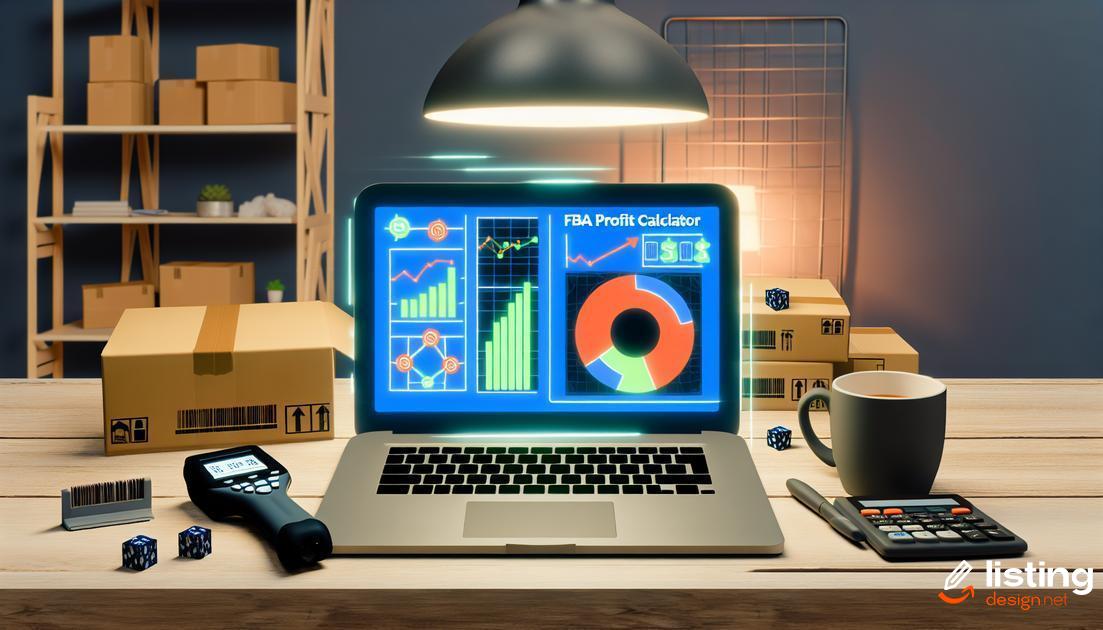Are you looking to maximize your earnings on Amazon? Utilizing an Amazon FBA profit calculator can be a game changer. These tools provide detailed insights into fees, costs, and potential profits, helping you to make informed decisions. In this article, we will explore various aspects of FBA profit calculators, including key features and tips to optimize your product listings.
Table of Contents
What is an Amazon FBA Profit Calculator?
An Amazon FBA Profit Calculator is an essential tool for sellers utilizing Amazon’s Fulfillment by Amazon (FBA) service. This online calculator helps sellers estimate their potential profits by taking into account various costs, such as Amazon’s fees, shipping costs, and other associated expenses. By inputting key details about their products, sellers can get a clear picture of their net profitability.
These calculators are designed to be user-friendly, providing detailed breakdowns of costs and expected revenues. Sellers can make informed decisions about pricing, product selection, and inventory management by analyzing the data from the profit calculator.
Using an Amazon FBA Profit Calculator can significantly enhance a seller’s ability to strategize and optimize their Amazon business operations, ultimately leading to increased earnings and successful ventures.
Why Use an Amazon FBA Profit Calculator?

Why Use an Amazon FBA Profit Calculator?
An Amazon FBA Profit Calculator is an essential tool for sellers aiming to maximize their earnings. By utilizing this calculator, you can accurately estimate your profit margins, ensuring that all related costs are accounted for. This tool helps in making informed decisions about pricing strategies, inventory purchases, and overall business planning.
One of the primary advantages is the ability to predict your return on investment (ROI) before committing to a product. The calculator takes into consideration various fees and costs, including Amazon’s selling fees, fulfillment fees, storage fees, and shipping costs. By entering these figures, you avoid unexpected expenses that could cut into your profits.
Moreover, using an FBA Profit Calculator can significantly streamline your workflow. It allows for quick, on-the-spot calculations that save time and reduce manual errors. This level of efficiency is crucial for maintaining a competitive edge in the fast-paced e-commerce market.
Another key benefit is strategic product selection. The calculator helps identify high-margin products, enabling sellers to focus on items with the best profit potential. This targeted approach minimizes the risk associated with introducing new products to your inventory.
Key Features of a Good Profit Calculator
A reliable profit calculator should offer user-friendly interface to help sellers navigate through the tool easily. It must include accurate fee calculations covering all aspects such as referral fees, FBA fees, and shipping costs.
Another essential feature is real-time updates, ensuring the calculations reflect any changes in Amazon’s fee structure or marketplace dynamics. The ability to
analyze gross profit and net profit
accurately is crucial to understand the final earnings after all expenses.
It should provide a comprehensive breakdown of costs and revenues, allowing sellers to identify areas for cost-saving and increased profitability. Integration with other tools, like inventory management systems and sales data analytics, enhances its functionality and practicality.
The calculator should support multi-currency calculations for sellers operating in different markets. It should also offer
customization options
to tailor the calculations based on specific business needs, such as varying product categories or shipping methods.
Finally, easy export options for reports and data ensure that users can quickly share and review financial analysis with stakeholders or colleagues.
How to Effectively Use an FBA Profit Calculator

To make the most out of an Amazon FBA Profit Calculator, it’s crucial to follow a structured approach. Start by entering precise product information such as the cost of goods, shipping fees, and other relevant expenses. This ensures that the calculator can provide accurate insights.
Next, consider leveraging historical sales data. By inputting your past sales figures, you receive more tailored projections. This step helps in identifying patterns and optimizing future sales strategies.
Another critical aspect is regularly updating the calculator with real-time data. Market conditions fluctuate, and so will your expenses and revenues. Keeping the calculator updated guarantees you get the most current profit estimates.
Additionally, use the calculator to perform scenario analysis. Experiment with different pricing strategies and see how they impact your profit margins. This practice helps in making informed decisions aiming to maximize your earnings.
Don’t forget to factor in promotional costs. Often, sellers overlook advertising expenses which can dramatically affect the overall profit. Include these to get a clear, realistic financial picture.
Finally, utilize the calculator to guide your inventory management decisions. By understanding your profit margins, you can decide which products to stock more of and which to phase out.
Advanced Tips: Explore integration with other analytical tools. Combining the profit calculator with inventory management or keyword research tools can provide a more cohesive and comprehensive business strategy.
Common Mistakes to Avoid with FBA Calculators
When using FBA calculators, accuracy is crucial. One common mistake is neglecting to update costs such as shipping fees, packaging, and storage. Always double-check these figures to ensure you’re working with the most current data.
Another frequent error is failing to account for Amazon’s referral fees, which can vary by category. Make sure you select the correct category to avoid inaccurate estimates.
Ignoring Seasonality Effects
Seasonal changes can significantly influence shipping costs and market demand. Ensure you incorporate seasonality into your calculations to get a clear picture of your potential profits throughout the year.
Overlooking Competitive Pricing
To remain competitive, regularly compare your prices against those of other sellers. Ignoring your competition can result in overpricing or underpricing your products, both of which can hurt your profitability.
Lastly, failure to include promotional costs in your calculations can lead to misleading profit estimates. If you’re running advertisements or promotions, incorporate these costs to get an accurate picture of your net profit.
Top Amazon FBA Profit Calculators Reviewed

Top Amazon FBA Profit Calculators Reviewed
Finding the right Amazon FBA profit calculator can be daunting given the variety of options available. Below, we highlight some of the top choices to help streamline your decision-making process:
1. AMZScout FBA Calculator
The AMZScout FBA Calculator allows users to input detailed product data to estimate profitability accurately. Its user-friendly interface and comprehensive cost breakdown make it a favorite among sellers.
2. Helium 10 Profitability Calculator
Helium 10 offers extensive tools for Amazon sellers, but its profit calculator stands out. The tool provides a clear analysis of all costs, including fulfillment fees, and helps in determining the best price point for your products.
3. SellerApp Profit Calculator
SellerApp’s calculator integrates seamlessly with its suite of seller tools. It offers real-time data and detailed reports, making it an excellent choice for those looking for in-depth profitability analysis.
4. Jungle Scout Profit Calculator
Jungle Scout’s profit calculator is known for its accuracy and ease of use. It offers insights into various costs, including shipping and storage, helping sellers maximize their earnings.
5. Fetcher Profit Calculator
Fetcher provides an intuitive profit calculator that simplifies FBA calculations. Its detailed breakdowns of Amazon fees and customizable reports help sellers make informed financial decisions.
Conclusion
These top Amazon FBA profit calculators each offer unique features designed to help you maximize your earnings. Choosing the right one depends on your specific needs and the detailed functionalities you require.
Case Study: Improving Profits Using a Profit Calculator
In a real-life application, leveraging a profit calculator can substantially boost your business performance on Amazon FBA. This case study examines a small e-commerce store that utilized a profit calculator to refine their pricing strategy and enhance their overall profit margins.
Initial Analysis: The store initially struggled with understanding the true costs associated with Amazon FBA. By inputting their product details into the profit calculator, they gained valuable insights into their net profits after accounting for FBA fees, shipping costs, and other expenses.
Actionable Insights: Armed with this data, the store adjusted its pricing model. They identified products with lower profit margins and either negotiated better deals with suppliers or adjusted their sales strategy to focus on more profitable items.
Results: Within six months, the store saw a significant increase in their profit margins. The profit calculator allowed them to make data-driven decisions that directly impacted their bottom line. The tool’s ability to forecast potential earnings and expenses helped them stay competitive in the marketplace.
By repeatedly integrating the profit calculator into their business processes, the store continually optimized their product offerings and pricing strategies, ultimately leading to sustained growth.
Understanding Amazon’s Fees and Costs

Amazon FBA fees and costs can significantly impact your profit margins. These include various expenses such as referral fees, fulfillment fees, and storage fees. It’s crucial to have a clear understanding of each to ensure accurate profit calculations.
Referral Fees: These fees are a percentage of the selling price and vary by category. For example, the referral fee for Amazon device accessories is 45%, while it’s 6% for cameras.
Fulfillment Fees: Charged per unit, these include picking, packing, and shipping fees. The rate depends on the product’s size and weight. For instance, standard-size items are cheaper to fulfill compared to oversized items.
Storage Fees: Amazon charges monthly inventory storage fees and long-term storage fees. These are based on the volume of your inventory, measured in cubic feet. Monthly storage fees apply to all items stored in fulfillment centers, with higher rates during October to December.
Additional Costs: Other costs include return processing fees, removal order fees, and unplanned service fees. If your product is returned, Amazon charges a return processing fee. Removal order fees apply if you request to have your inventory returned to you or destroyed. Unplanned service fees are incurred if your shipment to an Amazon fulfillment center doesn’t meet their requirements and needs additional services.
Knowing these fees helps in optimizing pricing strategies and choosing the right products to sell on Amazon. An Amazon FBA Profit Calculator can simplify this process by providing detailed insights into your expenses and potential earnings.
Optimizing Your Product Listings for Higher Profits
Enhancing your product listings is a critical strategy for boosting profits on Amazon FBA. Effective optimization can improve visibility, increase conversion rates, and ultimately drive more sales.
Use High-Quality Images and Videos
High-resolution images and engaging videos can significantly impact your product’s appeal. Ensure that all visuals are clear, professional, and show the product from multiple angles. Demonstrating the product in use can also help potential buyers envision its applicability.
Optimize Your Product Title
A well-crafted title should include relevant keywords and provide a clear description of the product. Make use of SEO best practices by incorporating terms that customers are likely to search for, without making the title too lengthy or keyword-stuffed.
Leverage Bullet Points
Bullet points in the product description make it easy for potential buyers to quickly understand the key features and benefits. Focus on the unique selling points, qualities that differentiate your product from competitors, and any critical information like size, material, or usability.
Write Compelling Product Descriptions
The product description should expand on the bullet points, providing detailed information that convinces users to make a purchase. Use persuasive language, adhering to a conversational tone, and highlight how the product solves a problem or improves the buyer’s life.
Incorporate Customer Reviews and Ratings
Social proof is a powerful tool in e-commerce. Featuring positive reviews prominently on your listing can build trust and influence buying decisions. Make sure to manage and respond to reviews, showing that you value customer feedback.
Utilize Backend Keywords
Backend keywords are hidden search terms that help your product appear in relevant search queries without crowding the main listing. Conduct thorough keyword research and input these terms into the backend sections to enhance discoverability.
Advanced Tips for Maximizing FBA Profit Margins

When looking to maximize your FBA profit margins, it’s essential to go beyond the basics and leverage advanced techniques. Here are some expert tips to boost your profits:
- Bundle Products Strategically: Combining related items into a single listing can increase perceived value and drive higher sales volumes.
- Leverage Seasonal Trends: Analyze market trends to stock up on seasonal products ahead of time. This approach can help you capitalize on peak demand periods.
- Optimize Inventory Levels: Utilize tools to monitor sales velocity and adjust inventory levels accordingly. This practice helps avoid both overstock and stockouts, maintaining a healthy cash flow.
- Dynamic Pricing: Implement dynamic pricing strategies to stay competitive. Use automated tools that adjust your prices based on competitor pricing and market demand.
- Enhance Product Listings: Invest in high-quality images, detailed descriptions, and relevant keywords. Optimizing these elements can enhance the visibility and attractiveness of your products.
- Expand Internationally: If feasible, consider expanding your FBA business to international markets. This can open up new revenue streams and diversify your income sources.
- Monitor FBA Fees Regularly: Amazon’s fees can fluctuate. Regularly review these costs and adjust your pricing strategies to ensure that you maintain healthy profit margins.
Advanced strategies such as these can significantly impact your FBA business’s bottom line, ensuring steady growth and maximized profits.
Integrating FBA Calculators with Other Tools
Boost Efficiency with Automated Data Transfer
Streamlining your workflow by integrating your FBA calculator with other tools can save time and reduce errors. For example, linking your calculator to your inventory management system ensures up-to-date data without manual entry.
Enhanced Analysis with Combined Data
Combining data from your FBA calculator with analytics platforms can provide deeper insights. This allows you to track key performance indicators and adjust strategies accordingly.
Seamless Integration with Accounting Software
Connecting your FBA calculator to accounting software can simplify financial tracking. Automated synchronization ensures accuracy in profit and loss statements, enhancing financial management.
Simplify Pricing Strategies
Integrate your FBA calculator with repricing tools to dynamically adjust your product prices. This integration helps in staying competitive while maximizing profits.
Comprehensive Dashboard for Centralized Monitoring
Using tools that offer a combined dashboard lets you monitor everything from sales margins to inventory levels in one place. This helps in making more informed decisions quickly.
Future Trends in Amazon FBA and Profit Calculation

As we look ahead, the landscape of Amazon FBA (Fulfillment by Amazon) and profit calculation is set for significant transformation. Emerging technologies and consumer behaviors are redefining the way sellers operate and calculate their margins.
Artificial Intelligence and Machine Learning
The integration of artificial intelligence (AI) and machine learning (ML) into profit calculators can provide more accurate predictions and insights. These technologies can analyze vast amounts of data to forecast sales trends, seasonal demand, and even competitor pricing strategies, enabling sellers to make informed decisions swiftly.
Real-Time Data Analytics
Real-time data analytics is another trend gaining traction. As market conditions change, having access to up-to-the-minute data can help sellers adapt pricing strategies and inventory management instantly. This is essential for maintaining a competitive edge in a fast-paced marketplace.
Blockchain for Transparency
Blockchain technology offers enhanced transparency in supply chain management. By utilizing blockchain, sellers can ensure traceability of their products, reduce fraud risks, and build greater trust with consumers.
Integrated Financial Services
Future profit calculators will likely integrate financial services such as lending and investment options. This will not only aid in managing cash flow but also provide opportunities for growth and expansion. These integrated services can help streamline financial processes and reduce the complexity of managing multiple financial streams.
Enhanced User Experience
The focus on user experience (UX) is predicted to intensify. Simplified interfaces, comprehensive dashboards, and personalized insights will make it easier for sellers to navigate complex data and optimize their operations efficiently.
By staying abreast of these future trends, Amazon FBA sellers can better prepare for the evolving e-commerce environment and leverage profit calculators to maximize their earnings.


